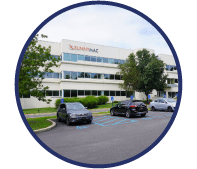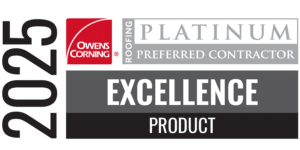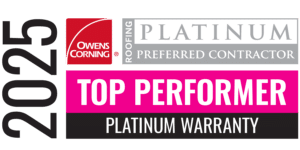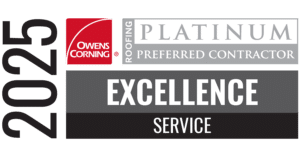One of the most important decisions homeowners make is their choice of installer. The roof is an essential part of any home. It provides shelter, regulates temperature, and plays a vital role in energy efficiency. Yet, many homeowners are unfamiliar with the basics of roofing replacement or questions to ask when choosing a roofing installer. Rest assured, this guide will give you the knowledge, vocabulary and talking points needed to help make an educated decision on who will install your new roof.
When To Inspect Or Replace Your Roof
It’s important to perform routine inspections and maintenance to extend the life of your roof. There are instances when a professional inspection is needed to ensure the roof is still doing it’s job:
Age of the Roof
If your roof is nearing the end of its expected lifespan (around 20-30 years for asphalt shingles), it’s time for an inspection.
Visible Damage
When cracked, warped or missing shingles are visible, or there is clear damage to the flashing, it’s time to have the roof inspected and determine if a new roof is needed.
Leaks or Water Stains
Immediately address any water stains on your ceiling or in the attic, as this could be a sign your roof is leaking. It’s a good idea to inspect your attic routinely to catch issues as early as possible.
Moss or Algae Growth
Moss and algae can trap moisture against the roof and cause damage over time. It’s a good idea to have it removed to maintain the health of your roof.
Sagging Roof Deck
A sagging roofline is a serious issue and could mean you have structural damage. Have the roof inspected as soon as possible to prevent major damage.
Roof Components:
If you need a replacement, it’s important to understand the components making up the roof so you can ask the right questions and make an educated decision about who will be hired to install it. Below are the main components:
Decking
The base structure of your roof, usually made of plywood, tongue and groove T&G board, or oriented strand board. It supports all other roofing materials. A quality roofer will thoroughly inspect all areas of the deck for delamination, water damage, or broken sheathing. They will take photos of anything discovered to create a plan for addressing these issues before installing the new roof. Any trustworthy company will make sure the deck is in great condition before any work is done.
Drip Edge
Drip edge is a special flashing installed along the entirety of the roof’s edge. Its job is to provide protection by directing water away from the fascia and soffit. All drip edges and pipe collars should be replaced unless there is a valid reason, such as they are historical and valuable to the home. They should be installed over the underlayment at the rakes, and under at the eaves. Shingles should overlap the drip edge slightly.
Ice and Water Barrier
A waterproof layer that protects your roof deck from ice, water and environmental elements. It is applied in all places that will be exposed to water, such as eves, valleys and any openings, such as chimneys or skylights.
Underlayment
A waterproof barrier made of synthetic fiber or felt that is installed between the decking and shingles or tiles. It protects your decking from moisture and the environment. Quality roofers will replace the underlayment and ensure it is applied directly to the deck. There shouldn’t be any water or ice present during this time, and it should be free of debris.
Flashing
A thin material, usually steel, aluminum or copper that is installed around chimneys, skylights, vents, and other roof penetrations to prevent water leaks. It should be nailed onto the decking and the length should be enough to provide full protection.
Shingles
The visible, outermost layer of your roof. They are designed to protect your home from weather elements. Shingles have multiple layers, including an asphalt base, over fiberglass or another material, with a gravel layer on top. Some companies use starter strip shingles, which provide stronger adhesion to prevent lifting. A quality roofing installer will choose a durable and trusted brand and provide a variety of color options.
Ridge Vents
Installed along the roof’s peak, they allow warm, humid air to escape from your attic, improving ventilation and preventing moisture build-up.
Ventilation
Certain procedures should be followed to ensure your roof can “breathe” and prevent moisture and heat retention. Trapped moisture can lead to mold and trapped heat can cause expansion and retraction, which could cause nails and other elements to loosen. Proper ventilation also protects the life of your roof and promotes energy efficiency. A quality roofer will look at soffit intake and gable vents to ensure the net free ventilation area (NFVA) is satisfied with the right product. They will also ensure there are no blocked soffits and there is proper air circulation.
Roofing Warranties
Always choose a reliable roofing installer with a long history serving your area. It’s best to choose one rated A+ by BBB with great reviews from many other customers. Ensure your roof installer provides an in-depth warranty and elements of the warranty are spelled out in the document. Although rare, some companies provide warranties on both materials and workmanship (SunnyMac does). It’s a good idea to protect your investment by comparing multiple companies’ warranties.
Including Solar Panels with Your Roof
If you’re considering solar panels, it’s a good idea to install them at the same time as your new roof. This will reduce the need to have panels removed due to a new roof installation. However, with utility rates continuing to rise, now may still be a great time to install solar. If you’re considering transitioning to solar, look for a company rated A+ by BBB with a long-standing history installing roof and solar.
About the Authors
Rick Manero, Lead Roofing Foreman
Rick has over 30 years of roofing experience and over 10 years of experience installing solar. His highly-specialized career has focused on the installation of roofs with solar over the last 10 years, leading to his work being featured in national publications. He delivers hands-on, in-depth training to members of the roofing department and other teams throughout the company. Every roof installed by SunnyMac is reviewed by a minimum of seven specialists. Rick has provided the highest quality craftsmanship to thousands of customers.

Steven Flath, Roofing Department Head
As SunnyMac’s Roofing Department Head, Steven leads a team of over 50 roofing specialists, including supervisors and foreman who are on-site at every roofing project. He oversees operations and the development of and adherence to strict standard operating procedures that ensure SunnyMac maintains its Owens Corning Platinum Preferred partnership, one of the highest designations available for roofing contractors.

About SunnyMac
SunnyMac is a full-service solar EPC (we manage the engineering, procurement and construction of our solar projects) and roofing installer proudly serving customers in DE, MD, PA, and NJ. We are an Owens Corning Platinum Preferred Partner and have transitioned over 12,500 homes to solar energy. We provide extended warranties on both product and workmanship.
A portion of our roof installations are inspected by Owens Corning to ensure all guidelines are followed, so you know you’re in good hands. Not only that, all photos collected during site survey are reviewed by a minimum of seven in-house team members. During install day, we send a Roofing Supervisor to answer any questions and oversee the entire project, as well as a Roofing Foreman to oversee the installation. Contact us today!





